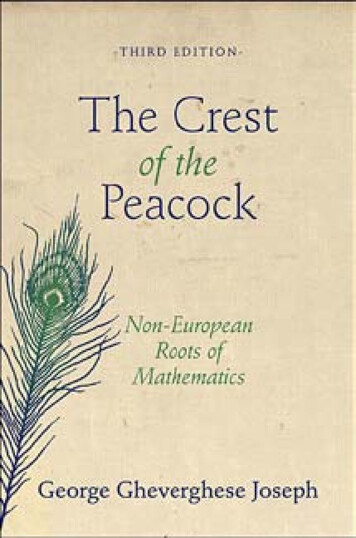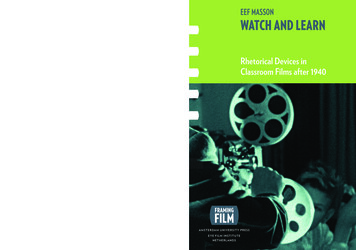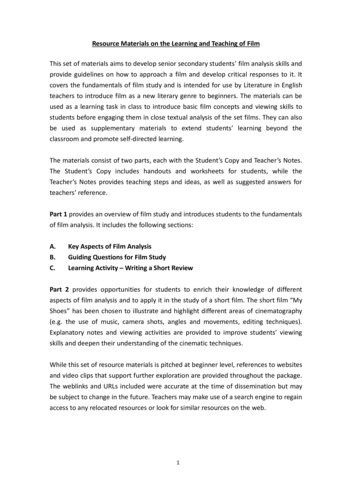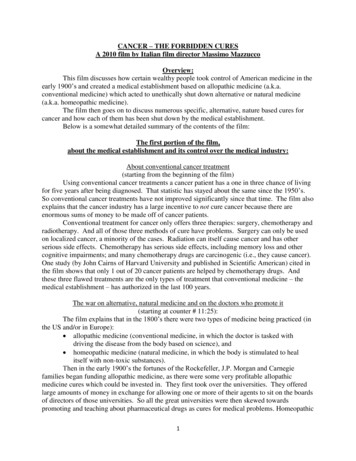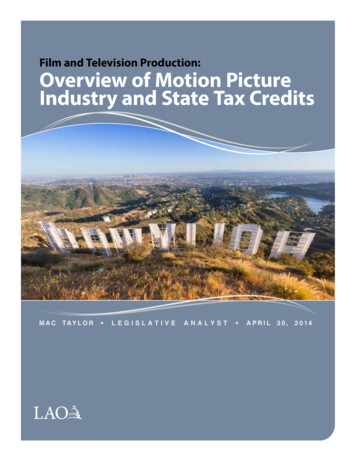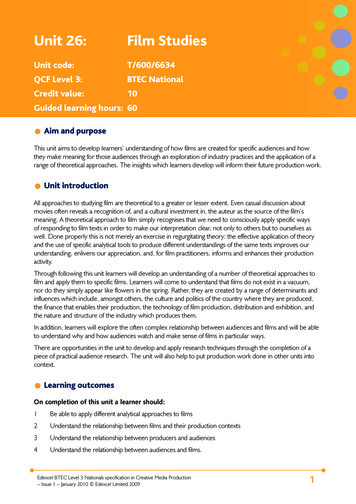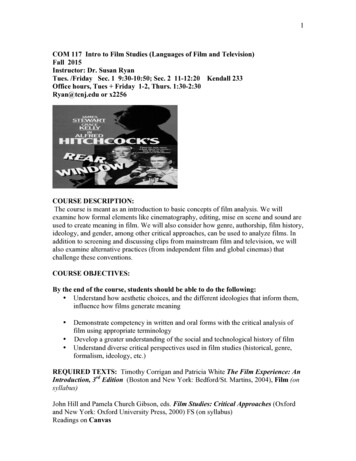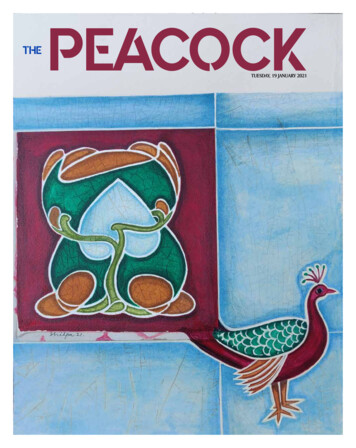
Transcription
THE PEACOCKTHEPEACOCKTUESDAY, 19 JANUARY 2021
2TUESDAY, 19 JANUARY 2021THE LONG VIEWREADING IN THE DARKBY DAMODAR MAUZOIIllustration: Pakhi Senoften wonder why everyyear at IFFI, I see a numberof writers from across thecountry flock to attend thefestival. I personally love to watch filmsat the festival for two reasons: the filmsare well selected, and the quality of thereels and screening is effectively good.But there is more to it - I easily getconnected to films as I do when I reada book.When I tried to find answers to thisthought, I received diverse responses.One said, ‘I find characters that Iwouldn’t meet in my vicinity’. Theother explicitly replied, ‘I come tosee if my works are worth adaptingto films.’ Yet another opined that hewants to imbibe the skill of minimalcommunication. Whatever their takeis, there is some direct connect thatattracts the literary fraternity to thefestival.A good film has all the elements of agood literary piece. Does that indicatethat literature and film mean one andthe same? As I ponder over this, Irecollect a saying that was in voguein Goa during the Portuguese colonialdays. Babu- Shabu, pouca diferença(there is little difference betweenBabu and Shabu - both proper namesprevailing then). Well, I am moreinterested in finding common groundrather than hitting upon dissimilarities.I recall how the filmmaker, actor, andactivist, Ms. Nandita Das, at a literarygathering a decade back, claimed thatshe did not belong to the writers’fraternity. It was when she was in Goaat the behest of the Konkani BhashaMandal to deliver a memorial lecture. Ihad then insisted that what she writesfor films is literature. I remembertelling her that though her film Firaaq(2008) was an ensemble based on athousand true stories, it read like anovel to me. She’d then agreed that itwas a narrative told in moving images.Nandita went on to bag the BestScreenplay Award at the Asian Festivalof First Films (2008) and in 2019, shewas nominated for the Best Screenplayand the Best Dialogue for the FilmfareAwards. She went on to write a book,Manto and I, that chronicled her journeyof making the film Manto (2018). ThisI cite as an example of how filmdombrought out the writer in her.I know of another writer who took topen after serving for Tollywood for 14years. Ashokmitran (real name JagadisaThyagarajan, 1931 - 2017) worked atGemini Studios in public relations. Onresigning from the Studios, he choseto become a full-time writer and soonattained great heights. His knowledgeof films and experience in the filmindustry, where he interacted with allkinds of people, helped him grow instature as a writer.We see many good novels made intofilms. Mario Puzo’s The Godfather (1969)was made into a film by the same title.Soon after the novel was published,Paramount Pictures, who saw thepotential, jumped on it to get therights from the author, even before thenovel became popular. The screenplaywas written by Francis Ford Coppola,with Puzo as co-writer. The novelbecame a New York Times bestseller andsold over nine million copies over twoyears. Meanwhile the film became a hitat the box office too and went on tobag multiple Academy awards. Both,the novel and the film are great in theirplace. Like most derivative works, heretoo a few changes were made thatwere acceptable to the author. Yet, thecritics univocally agree that both areremarkable works of art with neitherbeing better than the other.Devdas (original title Debdas in theoriginal Bangla) is a literary work bySharat Chandra Chatterji that is themost filmed fiction work in India. Onthe novel written in 1917, the filmwas made in multiple languages andmultiple times. The films were made inBangla, Hindi, Assamiya, Urdu, Tamil,Telugu, and Malayalam. The storyattracted the filmmakers right fromthe days of the silent movie of 1928 somuch that, from P.C.Barua’s Devdas of1935 to the modern-day appropriations(such as Daas Dev 2017) directed bySudhir Mishra, Devdas has at least 20versions. That is the magic of goodliterature finding its way into films.R. K. Narayan’s 1958 evergreenclassic, The Guide, is yet anotherexample of how literature connectswell with films. Considered as one ofthe 20th-century classics, the novelis made into a film that became anall-time-great movie. Time magazineproclaimed the film as the fourth-bestBollywood classic.In Goa, the imaginative film director,Laxmikant Shetgaonkar, made a filmbased on the Konkani novel, Adrusht,by Mahabaleshwar Sail as PaltadchoMunis (2009) that was awarded theFIPRESCI prize at the Toronto Festivalin 2009.Of course, the diehard bookenthusiasts will never agree that filmsare literature. They’ll say that it isimagination served on a platter. In thesame breath, I can vouch for many filmaficionados, who will not prefer a bookto a film. I’d like to believe though thatwatching a film is reading a book in thedark.Damodar Mauzo is the pre-eminentauthor of Konkani literature.
THE PEACOCKTUESDAY, 19 JANUARY 20213PRIDE AND PREJUDICEBY SACHIN CHATTETo say that the best thing about afilm festival is films is like sayingthe sky is blue. But there is a largerpoint to that – at a festival, you getto see films which would never make itto our theatres. With the advent of OTTplatforms, some of these films do make itto curated platforms like MUBI, but at theend of the day, nothing compares to theexperience of watching a film on the bigscreen, in the darkness of the theatre.It is the subject and themes that areportrayed in these films that make themso fascinating. In India, we all have grownup on a staple diet of mainstream cinema,no matter which part of the country youcome from. My love for cinema startedwith watching Amitabh Bachchan weavehis magic, back then on a single screen,when the choice of timing was restrictedto matinee, first or second show. Manyof the mainstream films were purekitsch and the thing about kitsch is thatonce you learn to appreciate that kindof cinema, some of it rubs off on youfor the rest of your life. For example,Mehul Kumar’s Tiranga (1992) wasoften screened either on Independenceor Republic Day – it is a film that is sobad that I love it. It has a villain calledPralaynath Gendaswamy who, in theclimax, tries to launch the fakest lookingmissiles ever and cause destruction allover India. That is the most fun I have hadwhile watching a terrible film.This brings me back to festivals andthe kind of movies that we get to see.Monday morning started with Suk Sukmade by a Hong Kong filmmaker, RayYeung. We have seen several films onrelationships and the complications thatarise with them – we have seen an olderman, a younger woman, and vice versa.When it comes to LGBTQIA though, thethemes have only been partly exploredbecause the subject is still taboo in partsof the world. The gates have opened butonly partly.Suk Suk (2019) aka Twilight’s Kiss is anextremely sensitive portrayal of twoelderly men, who are secretly gay – theyare both in their 70s and have spent mostof their lives fighting to keep it a secret.In the twilight of their life, they still haveto struggle because they both have theirrespective families to deal with. We seethe travails they have to go through inmaking their choices - Pak (Tai Bo) drivesa taxi, and has a wife and two grownup children while Hoi (Ben Yeun) is adivorcee, who lives with his rather strictson and his wife and daughter.“In general,the IFFI vibeis awesome.The wholeexperience ofwatching goodmovies withpeople, sharingthe experience,and talkingabout reviewsis great.”“I have beenattending IFFIsince 2016. I amhere to connectwith filmmakersand watch filmsfrom Iran andAfghanistan.”“I try to catchEuropeanmovies sincethey won’tcome hereotherwise.And Germancinema, inparticular, sinceit was my entrypoint into filmfestivals.”Ashika Singh,ArchitectGoaUmesh Deokar,DirectorKolhapurDipti Sharma,ScreenwriterBombayYeung manages to make us empathizewith both the lead characters – you feelfor them. Why can’t these two men livepeacefully and do what they want todo? Even to go to the market to buyingredients to cook a meal, they have tomake elaborate plans. How much can andshould society impose its own-made ruleson individuals? As we see them go abouttheir lives, it is also clear that whetherthe families are religious or not, there isdiscrimination and stigma which is hardto overcome – needless to say, whenreligion is involved, the fight becomesthat much tougher, as activists aroundthe globe and in India, discovered aswell. Hong Kong decriminalized gay sexin 2019, a year after the Supreme Courtstruck down Section 377 in India.Back home, when we see anLGBTQIA character in cinema, it ismostly for comic effect or to make fun of.A film like Aligarh (2015) is an exceptionto the rule and Bombay Talkies (2013),the anthology had one story that hadsome gravitas while there has been theodd regional film that has shown someseriousness in the portrayal.Badnaam Basti (1971) was one of theearliest films produced that depicted aa gay relationship. There was no copy ofthe film until they found a 35mm print inBerlin, last year. Incidentally, the film wasco-produced by Film Finance Corporation,which went on to become the NationalFilm Development Corporation (NFDC).As it has been often mentioned,cinema plays a huge role in shapingthe sensibilities of our society –LGBTQIA rights and their acceptance stillhas to go long way in our country but onthe positive side, it is taking baby stepsforward and cinema can play an importantpart in the process.I certainly didn’t learn anything fromGendaswamy’s missiles but I could feelthe pain of Professor Ramchandra Sirasin Aligarh and the predicament of Pakand Hoi, the elderly gents in Suk Suk – allthanks to cinema.“I like to traveland watchfilms. Thisis my firstyear at IFFI.I am lookingforward tomeetingprofessionalsfrom SouthIndia as well.”Soumil Tiwari,AssistantDirectorMumbai
4THE PEACOCKTUESDAY, 19 JANUARY 2021THE TASTE OF PHO:CULINARY CINEMABY KAVITA MASTHOFFWarsaw doesn’t evokefeelings of multiethnicity.Nonetheless, it has a vibrantVietnamese community,which is one of the largest minorityethnic groups in the city. Today, Warsawis transforming into a melting pot ofcultures and that is what Mariko Bobrik,a Japanese director settled in Poland,dissects so beautifully and charmingly inThe Taste of Pho (2019).The focus of this Polish-Vietnamesefilm is on the large Vietnamesecommunity residing in Warsaw. Thename of the film could mislead a fewThere’s no social distancingin the queues;there are people tugging atmy shirt. Thereis no staff tokeep peoplein check. Whyis there noprotectionAdrianD’Cunha,RetiredConsultantGoato believe that they will embark on agastronomic journey, but The Taste ofPho is not about food. Rather, the iconicVietnamese dish represents a connectionto the past, and embracing the future,and family love. The movie hopes tostimulate emotions and Mariko Bobrikwholeheartedly succeeds with thischarming and thought-provoking drama.Long (Thang Long Do) works in anunassuming Vietnamese eatery and isa master creator of Pho. He has loyalcustomers, who throng the eatery tosavor this delicacy of beef and noodles.Long adheres to a strict daily routineand the repetitive actions of ironing hisdaughter’s pleated skirt and preparingher lunchbox, filled with Vietnamesefood, give him solace.Maya (Lena Nguyen), the 10-year-olddaughter, is battling the void left bythe demise of her Polish mother. Shewould rather eat Polish food than theVietnamese fare her father gives hereach day for school. While Maya lovesher father, she has issues revealing herfeelings and letting go of the past. Sheworries that her father will forget hermother and shift his attention to thesultry neighbor played by AleksandraDomanska. This prompts her to spy onthe neighbor and adds a fun elementto the movie. Long, on the other hand,is too steeped in his problems anddoesn’t notice the turmoil brewing inhis daughter. The owner of the eaterydecides to relocate to Vietnam andsells his business to a Polish man, whoconverts it to a sushi restaurant.Long is pulled between his Vietnameseroots and his adopted country’s culture.Bobrik uses unobstrusive hints to showthat Long was better able to cope withthis mishmash of identity while his wifewas alive and now, he is clinging to thepast that is long gone but it is his escape,Because ofCOVID, thisIFFI has lessresponse. Eventhe governmenthas restrictedthe registerednumber ofdelegates. It isgood but it islimited.We feel safe,privileged andhonored tobe here. Wejust saw onefilm on autismwhich nDacunha,DelegateGoaa safe haven. Long still believes thatgirls wear pleated skirts to school (likein Vietnam) and has no idea that Mayachanges into a pair of jeans the momentshe turns the corner. He prefers to getthings repaired instead of wasting moneyon buying new stuff unless spare partsare not available, like what happens tohis decrepit washing machine.As Long struggles to learn how tomake sushi and yearns for the old daysof Pho, he embarks on a journey of selfdiscovery and acceptance. The moviegradually reveals how Long adapts andresolves the issues plaguing his family.The Taste of Pho is Bobrik’s firstdirectorial venture. She ensures that thestory is not overdramatized. Instead, ithas a discerning storytelling touch toit. Viewers see rather than being told.Bobrik exquisitely uses objects to portrayprotagonists and their feelings andemotions. The warmly-lit interiors of thehouse convey the warmth of feelings andcloseness even though the father anddaughter relationship is troubled.Instead of making it region-specific,Bobrik ensures that the film has auniversal perspective so that viewers canidentify with family ties and alienation,and routine of everyday life. The Tasteof Pho takes viewers on a heartwarmingjourney of a family in its quest to findinner bliss and contentment.In the end, The Taste of Pho beautifullyshowcases the ramifications of migrationand how the older generation struggleswith changing culture while the youngergeneration effortlessly embraces andslips into the culture of the country theyare born in. The film score by Aki Takasedoes justice to the film with its enjoyablerhythm.The Taste of Pho is being screenedat Kala Academy (C53) at 18:00 on 19January 2021.IFFI is toogood. InOur World,about autisticchildren,showed theirwhole journeyas well as thatof their parentsand othersconnected tothem. It wasgreat.Jothi Shetty,Hotel ProprietorMumbai
THE PEACOCKTUESDAY, 19 JANUARY 20215THE APSARA OPPORTUNITYBY SUYASH KAMATOver the last 30 years or so,Madhu Apsara, a sounddesigner and professor,has silently played a crucialpart in many landmark Indian filmsand documentaries. Frequentlycollaborating with filmmakers likeSudhir Mishra and Sriram Raghavan,Apsara’s work always maintained therare ability to keep the narrative ofthe film at the fore while still retainingthe distinct quality of his design. ThePeacock virtually attended his class onSound Design & Cinema.‘How did sound come to cinemaand what did it do to it?’ ProfessorMadhu Apsara began by taking us backto the silent era of cinema. ‘Peoplewere happy with silent picture. Soundwasn’t a requirement.’ But over 20-30years, in the early 1900s, sound andmusic slowly started becoming a partof cinema. ‘While the images and titlecards conveyed the narrative, therewas a looming question of holdingthe attention of audiences.’ At thisstage, practitioners bought in the useof music played by orchestras thattravelled with the films. At times, thescore travelled and different orchestrasplayed them, primarily to cue theemotion on screen.But much like the introductionof any new element to an alreadyexisting method, sound wasn’tinvited wholeheartedly by a lot ofestablished silent era film directors,including Charlie Chaplin & AlfredHitchcock. ‘Hitchcock believed thatsound had taken purity out of thecinema.’ However, it’s not Hitchcock’sapprehension but his insight about thefunction of sound in the larger contextof storytelling that Madhu Apsarahighlighted upon. “At some level, weare still facing the same problemsthey faced despite the advances inIFFI is anopportunity towatch movieswith noncommercialconcepts. Wesaw movieswithoutdialogues,and had tounderstandmore bywatching thanlistening!Mark FernandesStudent, Goatechnology and the evolution of ourrelationship of working with sound”.Ironically, at this point, we can alsohear a few other sounds in thebackground of this class,which is an attempt atvirtually holding thesession withoutglitches.But sound hasevolved from that eraand Madhu Apsarabegan exploringthe history of soundthrough the approachessought by directors whochanged the form of cinema.“When Hitchcock beganworking with sound, at times, hewasn’t even bothered about whatdialogue was spoken, but insteadFor seniors it isnot comfortableas we find itdifficult toconstantlylook at phonescreens fordetails. Theremust besomething inprinted formatas well.Rispal SinghVikal,DirectorBombayabout how it sounded.” This idea ofworking with inflection instead of justinformation is what Apsara believesremains an extremely crucial aspectof how films sound. “Soundbeing parallel to the imagehas taken away theimportance of what itdoes to the cinema.”Federico Fellini,another master ofthe craft, similarlywrote dialoguesthat had a rhythmto them. “Fellinicomposed musicbefore he wrote a scene tounderstand the tonality of thescene and ultimately, never even usedthat music in the film. He even usedpitch variations to define differentI want towatch perioddramas anddocumentariesas I lovelarger-than-liferealistic films,which createan empatheticconnectionwith theaudience.Tharani Gosa,FilmmakerHyderabadcharacters.” Building upon the contextof rhythm, Apsara highlighted thework of Robert Bresson, who soughttemporality in his form through theuse of sound. “Bresson’s idea of theimage was about presenting, notrepresenting. To him, the emotionaltogetherness of the sound and thepicture is what created the image.”Back home, in India, Madhu Apsaraspoke about the work of Ritwik Ghatakand Mani Kaul. While Ritwik Ghatak’swork was sentimental, for Mani Kaulrestrain was the key. These definedpersonal approaches to cinema arereflected in their use of sound beyondthe conventional ideas of conveyinginformation. “In Meghe Dhaka Tara(1960), the use of sound in certainscenes doesn’t have any relation to thelocation. These sounds are aestheticinstruments. Sound then becomes ametaphor and conveys an emotionthat is beyond the image.” Mani Kaul,whose practice is associated withBresson’s approach to cinema, wasequally interested in the temporalityand rhythm that sound bought tothe medium. “Mani would designthe movement of a shot and explainits rhythm to the cinematographerby singing a phrase in the form of analaap. This sensation and emotion ofthe movement were communicatedonly through sound. And this reflectedin his cinema.”Ultimately, through the journeyof the associations held by directorswith sound, Madhu Apsara urgedeach attendee to find their personalconnection with sound. “Each of usgoes through sound experiences. Weare always experiencing the vibrationsof sound. It’s the last sensation thatshuts down when we go to sleep.That’s when live sound and dreamsound mix together. When we observethese, we realize how deeply theseaffect our subconscious.”I watchedPather Panchali (1955) for thetwentieth time,but on the bigscreen. I missthe crowdsand having apersonal hardcopy of the filmschedule.SobitaKudtarkar,ActorGoa
6TUESDAY, 19 JANUARY 2021PEANUT GALLERY: NADIA DE SOUZA‘Tim’s just masking his territory ‘
THE PEACOCKTUESDAY, 19 JANUARY 20217“YOU NEED TO HAVE CONVICTION ANDBELIEVE IN YOUR STORY TO MAKE IT”Every year, the selectioncommittee faces the difficulttask of shortlisting films forcinema lovers. This year we seesome budding young talent presentingtheir debut work at IFFI. Oru PaathiraSwapnam Pole (Like A Midnight Dream) isabout a mother who is diagnosed withcancer, and simultaneously discoversa nude video of her daughter onher laptop. It focuses on concurrentconflicts in the life of a mother, who hasto deal with her medical condition andquestion the way to control and protecther daughter.The film is shot in Kochi and portraysthe private lives of the characters.Informing The Peacock about theconcept, director, Sharan Venugopal,said that he doesn’t like to share spaceoften with people and is a man of fewwords. He connected with a short storytitled Vaibhavam written by his friendSusmesh Chandroth about exploringkinship ties in a private space. Hechanced upon this and made the filmas his diploma project as a student atSatyajit Ray Film and TelevisionInstitute, Kolkata. He is gratefulto his mentor, Putul Mehmood,from Satyajit Ray Film andTelevision Institute for herguidance during the film. Hetook a group of his closeconfidants onboard. Hewas skeptical about therelease of the film dueto the pandemic but isdelighted to be a part ofIFFI. He is also happy thatSouth Indian actor NadiyaMoidu played the role ofthe mother in the film.A significant aspect of the makingof the film was that it brought youngfilmmakers from different statestogether to produce a regionalMalayalam film. Sharan is from Kerala,Koustabh Mukherjee from Bengal isthe cinematographer, Jyoti SwaroopPanda from Odisha did the editing,Prathik Sonkar from Madhya Pradeshworked on sound, and Prateek Bagifrom Punjab is the producer. “Languagedoesn’t play a role in making a film. Weneed to understand the concept and bethorough with executing the project,”said Prateek.Speaking about portraying twowomen characters as a male filmmaker,Sharan said, “A filmmaker has to learnto be sensitive to understand charactersirrespective of gender. Mainstreamcinema, unfortunately, conforms tothe stereotype of using the male gazerather than depict the sensitive side. Iwanted to make a film in a sympatheticway. I have been inspired by the workof Polish director, Krzysztof Kieslowski,who has made films on women despitebeing a male filmmaker. We need morerepresentation from women in cinemaand I hope young women are inspiredto make more films,” Sharan said.The film also deals with theconflicting relationships betweenparents and children. Speaking aboutthis, Sharan reflected that in our culture,it is common for parents to want tocontrol the lives of their children whenthe latter seeks independence. Yet inthe film, the mother is a liberal womanwho encourages open conversationsdespite wanting to be conservative andassertive. The film encourages suchopen conversations.A great part of the film is based ina closed setting, a house with fewshots outdoors. “While working in aprivate setting, you need to understandthe mood of the scene and the wayyou have to communicate the same.I planned the movment accordingly”,Kaustabh said.Sharan plans to work more on filmsthat explore interpersonal relationships.“You need to have conviction andbelieve in your story to make it”, hesaid.Photo by Assavri KulkarniBY CHRISTAL FERRAO
TUESDAY, 19 JANUARY 2021THE SCOREIllustration: Pakhi Sen8“FREELY INSPIRED”BY DR. LUIS DIASThose are the words used byfamed Spanish filmmaker,director, screenwriter, producer,and former actor PedroAlmodóvar to qualify his film, The HumanVoice (2020), an adaptation of the Frenchpoet, playwright, novelist, designer,filmmaker, visual artist and critic JeanCocteau’s 1930 play Une Voix Humaine.The challenge Almodóvar faced wasturning a play lasting around 20 minutesor so into a feature-length film, andmaking it relevant to a contemporaryaudience. Cocteau’s play is set aroundjust one woman on stage speakingon the telephone to a lover (invisible,inaudible) at the other end of the linewho has decided to leave her to marryanother woman. In his introduction tothe script, Cocteau admitted that theplay was written in response to criticismfrom his actresses that his works weretoo “writer/director-dominated”, leavingthem little opportunity to give vent totheir histrionic range more fully.The play has already been adaptedby Roberto Rossellini (L’Amore, 1948,the second segment of which, Una VoceUmana is based on Cocteau’s work), andeven an opera (1958) by the great Frenchpianist-composer François Poulenc thatCocteau loved very much. Other filmadaptations include a television versionstarring Ingrid Bergman.Almodóvar wrote a new script, “freelyinspired” by Cocteau of course. And, hechose Scottish narrator and actress TildaSwinton for the singular role. He felt an“exceptional chemistry” with Swinton,translating from Spanish that theywere “condemned to be friends.” ToSwinton, despite their different originsand backgrounds, they share a commonlanguage and “culture of cinema.” Sowhen Almodóvar wished to draw out acertain emotion from her at a particularpoint, he would use cinematic referencesand metaphors, and she would get it atonce.In retrospect, even though it wasconceptualized before the Coronaviruspandemic struck, Almodóvar feels TheHuman Voice (which is also his Englishlanguage debut; all his other formidablework is in Spanish) has even morerelevance as it depicts the seclusion,isolation, and loneliness of someoneliving alone, shut off from the rest of theworld. “She’s almost imprisoned, isn’tshe?” he said through a translator viaZoom interview to Eugene Hernandez,Director of the New York Film Festival.“It turned out, just by coincidence, tobe a metaphor for the lockdown in thepandemic. Reality often slips in throughthe cracks of what you’re doing.”Almodóvar calls this film “a mixbetween the essence of theatre with theessence of cinema”, far from realism ornaturalism. The film title is apt, as theonly real element in it which guides theviewer, the continuity element of thefilm is “solely and exclusively” Swinton’svoice. The setting is “ghostly”, asSwinton’s character is “almost a ghostherself.”To Swinton, the tension in the originalCocteau play, between the protagonistwanting to tell her once-lover everythingabout her feelings to show him herpain on the one hand, and wanting tocreate a complete fabrication, on theother, and doing that on the telephone,which allows one to hear but not see theother was intriguing to her; the fine linebetween “inarticulacy and articulacy.”Almodóvar’s text is also about that same“dance”, that same “performance”; afterall, the character is an actress. It (beingjilted) is a predicament a lot of us 21 andabove have lived through, says Swinton.“Everyone who has been abandoned isalready in a soap opera.” The “twist andturn of sincerity and deception” makes ita rich text in Swinton’s view.Almodóvar compares the sentimentalepic nature of the abandoned woman’sfeelings, the heightened emotions thather character has to the musical stylepopular in his culture, the ‘bolero’;“the exaggerated way of living youremotions, the ups and downs, fromone extreme to the other, from feelingblissfully happy to feeling dreadful.”It calls for an actress with a wholevariety of registers, and he found this inSwinton.Spanish composer Alberto Iglesias hascollaborated with Almodóvar in all hisfilms after their first partnership in Laflor de mi secreto (The Flower of My Secret,1995), the last nine of Almodóvar’s 22feature-length films. That’s saying a lot,as before that Almodóvar has workedwith the legendary Ennio Morricone(Átame!, 1989) and Ryûichi Sakamoto(High Heels, 1991).Film fans will also have heardthe music of Iglesias in other, nonAlmodóvarian films, classics such asThe Constant Gardener (2005), The KiteRunner (2007), and Tinker Tailor SoldierSpy (2011). The Human Voice has a100% approval rating on the reviewaggregator website Rotten Tomatoes,with a weighted average of 9/10. Whenasked some years ago for the secret ofthe success of his films, Almodóvar hadreplied, “It’s important not to forget thatfilms are made to entertain. That’s thekey.”With such a stellar combination ofcollaborators, The Human Voice promisesto do exactly that.Dr. Luis Dias is a physician, musician,writer and founder of music educationcharity Child’s Play India Foundation www.childsplayindia.org. He blogs atwww.luisdias.wordpress.com.
THE THIRD EYETUESDAY, 19 JANUARY 20219THE MATURITY OFMIXED EMOTIONSBY DR RACHANA PATNIEIllustration: Raimotional intelligence is an areaof research and applicationpoised to grow even further inimportance in influencing oursocial world. An essential building blockof emotional intelligence is emotionalliteracy, which is linked to and helps withanother important aspect of emotionalintelligence, self-awareness.I work with (willing) others on theiremotional literacy because it turns outthat we are often not exactly on pointin feeling what it is we are feeling andwe often turn to knowing what it is thatwe are feeling, and make several moremistakes of omission and commission ingauging. If we go by how we are behavingto get a sense of what we are feeling,the mistakes may become even moreprominent as there are many diversionsbetween feeling and action. To share acommon example, children may behaveas if they are angry when the feeling theyare struggling with is that of sadness.As a parent, I often get the chance toexperience this, and I am aware that Ihave used anger to save myself fromfeeling the other emotions that makeme feel a lot more vulnerable. Anger,therefore, becomes a good diversiontactic and fear is often the motivationbehind those diversions.Our engagement with our emotionsis a creative undertaking and while itcan be pretty accurate, it is also beingconstructed narratively, and therefore itis reasonably open to re-storying. The restorying is best done with the intentionof clearing out any emotional debris fromour unprocessed emotional backlog,which may corrupt our experience of ourfeelings in the present moment.What are the ways in which we maycorrupt what we are feeling? Most of thetime, we bring unprocessed sedimentsof our past experiences into the present.In doing so, we let our past experiencesimpact our perception, physiologi
films. Mario Puzo's The Godfather (1969) was made into a film by the same title. Soon after the novel was published, Paramount Pictures, who saw the potential, jumped on it to get the rights from the author, even before the novel became popular. The screenplay was written by Francis Ford Coppola, with Puzo as co-writer. The novel

